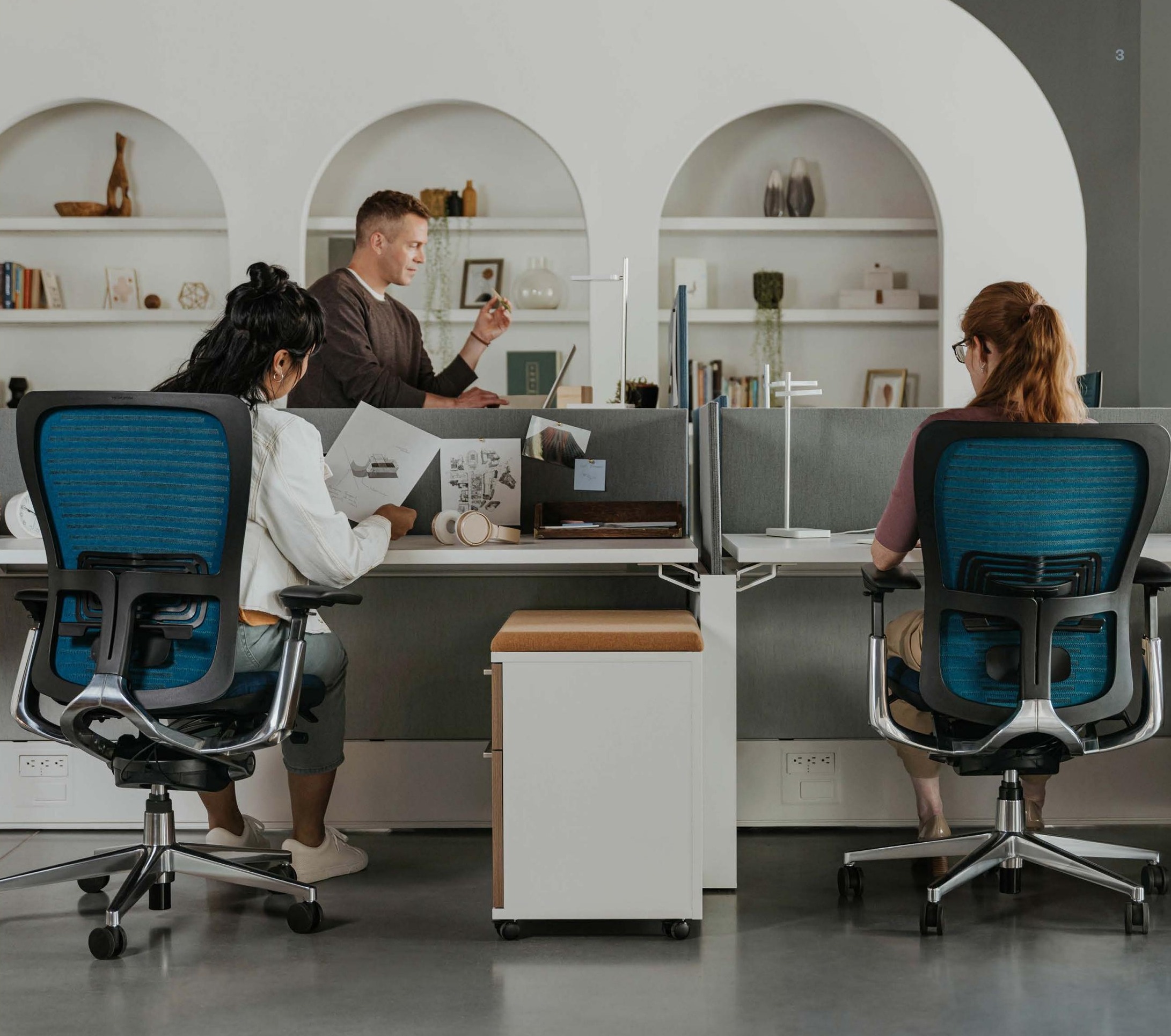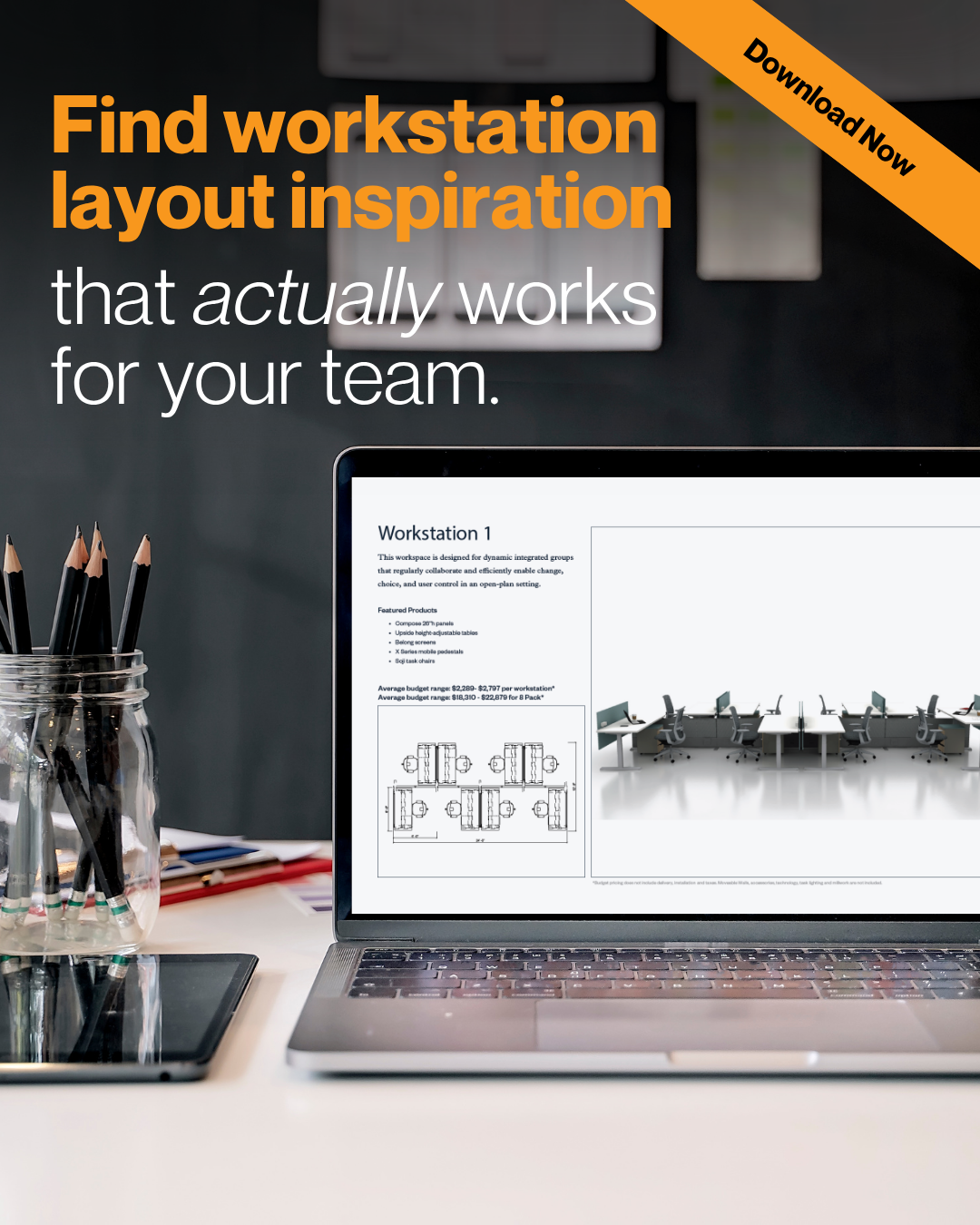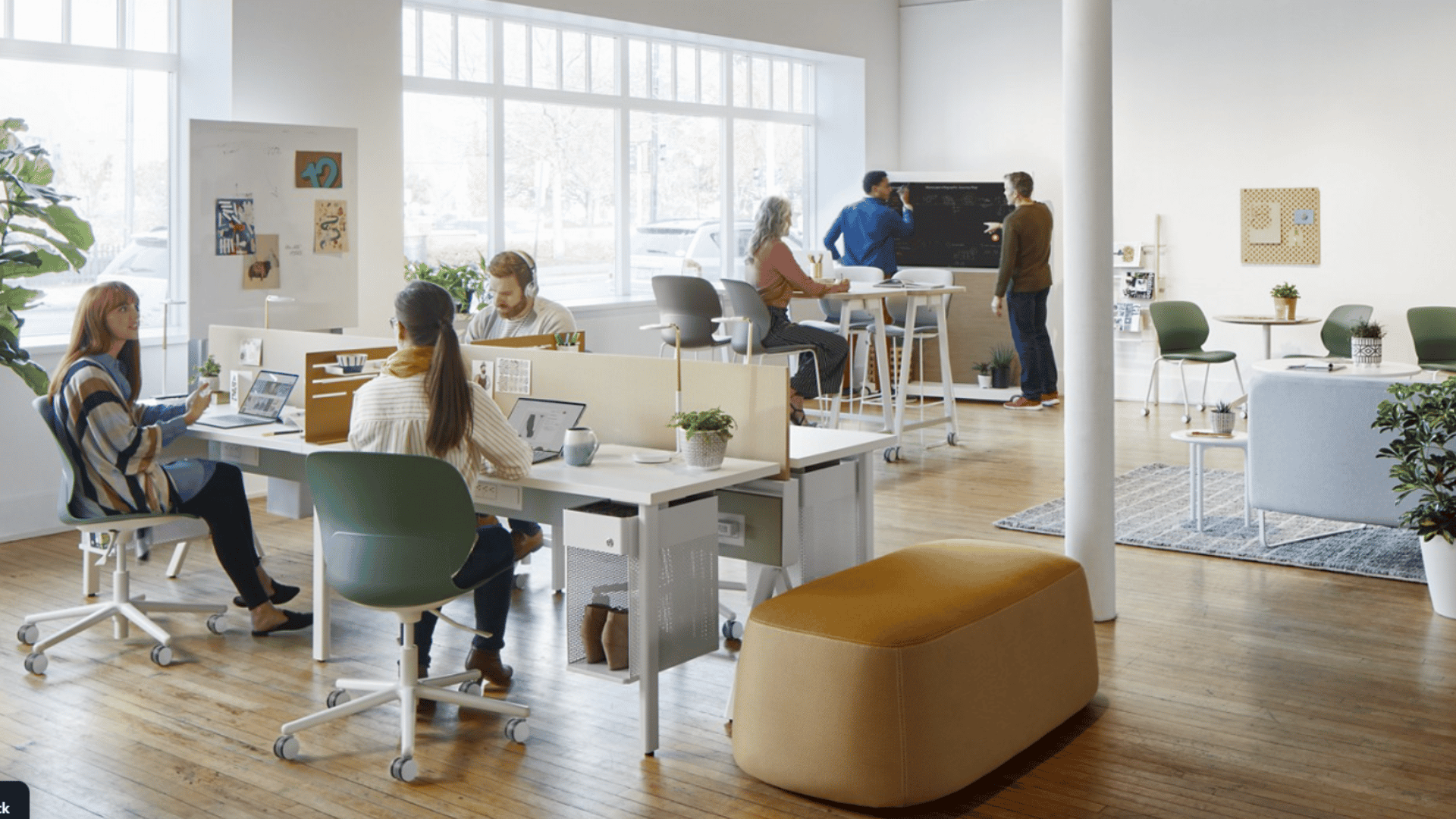Systems Furniture Workstations
Do more... in less space.
Create a productive, ergonomic, and professional environment with customized workstation solutions designed to support your team’s success.
Commercial real estate rates are increasing steadily, and as your company grows, your office space requirements grow as well, right? What if you could better utilize your office space?
A thoughtfully designed workstation does more than look good—it helps your team stay focused, feel comfortable, and collaborate more effectively. Whether you’re outfitting a single space or planning an office refresh, modular office workstations give you the flexibility, functionality, and modern design your team needs. Built to support today’s hybrid workflows and tomorrow’s growth, they’re as adaptable as your business.

What Are Systems Furniture Workstations?
And How Do They Work?
Are Systems Furniture Workstations Right for My Office?
Systems furniture—also known as modular workstations, office cubicles, or desk systems—is a flexible, efficient way to furnish modern offices. Instead of permanent walls or individual desks, these modular components use panels, surfaces, storage, and accessories to create tailored workspaces that can be rearranged as your team or space evolves.
Systems furniture is perfect for building workstations of almost any shape, size or configuration. Think of it as a Lego kit for office workstations.
Since systems furniture is modular by nature, you can go back at any time and add, remove or change components, individual workstations or even your entire floorplan.
Benefits of Modular Workstations
There are a few key reasons why most offices are deciding to use systems furniture. The benefits most frequently cited by users include their flexibility, cost and space efficiency as well as the level of customization they allow.
Space-Saving Office Layouts
Since systems furniture workstations can share panels, they require less total material for the full layout configuration.
Scalable Furniture Solutions
Modular systems adapt over time, allowing you to reconfigure instead of reinvesting. They can be dismantled, rearranged or moved and reassembled quickly, without waste and the sort of disturbance caused by a renovation.
Built-in Cable Management
Manage wires and devices more easily with integrated tech-friendly features.
Custom Desk Configurations
From quiet focus areas to collaborative zones, modular workstations match how your people work.
For example, the part of the floorplan dedicated to the accounting department might have higher panels for additional auditory privacy to support heads down, focused work than the section of the floor dedicated to the marketing team who need to collaborate and share ideas daily.
Get Inspired: View Our Workstations & Benching Systems Lookbook
Need ideas for your office? Our lookbook for workstation and benching system areas is packed with layout inspiration, configuration tips and budget estimates to help you visualize what's possible with Haworth furniture.

Workstation Options We Offer
We provide a broad range of modular workstation options from industry-leading manufacturers, including:
Height-adjustable desks
for ergonomic flexibility
Panel-based systems
for semi-private cubicle-style workstations
Open benching systems
for collaborative teams
How Much Does a Systems Furniture Workstation Cost?
Price points vary depending on the type, finishes, and number of units needed. Basic configurations (usually 6’ by 6’), typically start around $1,200–$5,000 per station.
Workstations come in a wide variety of configurations—from linear runs to L-shaped or U-shaped setups, clusters for teams, or pods for quiet work. Whether you’re designing for 2 people or 200, we’ll help you find the format that balances budget, collaboration, privacy, space efficiency.

Are There Any Downsides to Systems Furniture?
While modular workstations offer flexibility and space efficiency, they aren’t always the best fit for every team. Here are a few considerations:
-
Auditory Privacy: Because workstations are arranged closely and often share panels, sound can travel easily. Acoustic panels, sound masking, and thoughtful layout design can help address this.
-
Visual Distractions: Lower panel heights can lead to less visual privacy. This is easily managed by selecting taller panels or adding glass stackers.
-
Not DIY-Reconfigurable: Systems furniture is modular—but not necessarily 'moveable.' You’ll need professional installers to reconfigure it safely.
We’ll help you weigh these trade-offs and design solutions that minimize disruption while maximizing productivity.

Are Panel-Based Workstations Right for Your Office? Here’s How to Decide.
Panel-based workstations or systems furniture workstations are one of the most versatile and space-efficient solutions available—but like any office furniture solution, it’s not one-size-fits-all. Here’s when it’s a smart investment—and when it might not be the best fit.
You Should Consider Panel-Based Workstations If:
Our customers most satisfied with their decision to buy systems furniture workstations for their team are organizations that:
- Need a workstation that is easily customizable and collaborative
- Have expanding teams and space is limited
- Are looking to maximize office productivity and overall team wellness
Like we said above, when discussing the benefits, the main reasons to consider systems furniture is to create a flexible office layout that will best utilize your office space… and can be reconfigured to keep meeting those needs as they adapt and grow with your business.
Panel-Based Workstations Might Not Be the Right Fit If:
While we do recommend systems furniture to most of the businesses we work with, we also recognize that there are cases where they are not the best fit. In our experience, we recommend not to use systems furniture when:
- You require complete auditory privacy
- Your team needs full visual privacy (not just seated privacy)
- You have plenty of office space and don’t mind buying everyone a standalone desk
There are plenty of ways to improve the visual privacy and auditory privacy of an office using systems furniture but unless you use panels that span from floor to ceiling, they will never provide complete privacy.
Want to See Modular Workstations in Real Workspaces?
Explore our completed installations and layout solutions in our project gallery.
Nova Scotia Health Innovation Hub, Halifax
Adaptable Workstations with double as hotelling desks and breakout areas at the Nova Scotia Health Innovation Hub.
COWI, Halifax
The dedicated workstations with a single under-desk storage unit at COWI.
Lakeview Electric, Dartmouth
A customized workstation layout designed to support Lakeview Electric’s administrative team.
Have questions about modular workstations? You’re not alone.
Here are the answers to some of the most common questions we hear from businesses planning their next office upgrade.
What’s the best type of workstation layout for my office?
There’s no one-size-fits-all answer—it depends on your team, space, and how you work. In this article, we break down the most popular workstation layouts, compare their pros and cons to help you choose the setup that best supports your workflow and business goals.
How customizable are modular workstations?
Very.
The specific brand and product line you choose for your systems furniture will determine the finishes available to you, and hopefully, the exact specifications of your systems furniture will depend on the specific needs of your business.
However, there are still some standard finishes and specs that are inherent to most systems furniture products.
Fabric upholstery is the most popular (and least expensive) finish choice for workstation panels. There are plenty of other options available, though, if you are looking for an enhanced aesthetic or increased functionality.
Not only is there a considerable variety of colours and pattern fabrics available but you can upgrade the upholstery to a laminate or veneer, a writeable whiteboard surface, a tack board, or a slotted accessory rack for storing papers, pens and more.
The height of the panels is another area where you have much ability to customize your system. Panels can be as short as 34” or as tall as 74”, though they are most commonly 42”, 50”, or 58” unless you are adding a “stacker” on top.
These stackers can also be customized. You can order them in matching or complementary colours and finishes, or instead, you can use glass stackers. Glass stackers are available in clear, frosted or framed styles and are typically used to provide additional auditory privacy without blocking the light or visibility of a seated user.
How much does a modular workstation cost?
Pricing varies based on configuration, finishes, storage, and optional features like height-adjustable desks. Most fall between $1,200 and $5,000 per station. We’ll work with you to provide an estimate that fits your budget and needs.
What are some factors that may affect pricing?
How can you determine where within the price range you will fall? Here are the four elements that will most impact how much you end up paying for new systems furniture:
- Panel Height – Higher panels require additional material and will, therefore, increase the total cost of the workstation.
- Finish Selection – Your choice of finishes can significantly increase your overall price. Upgrading the panel material from fabric to laminate, veneer or whiteboard and adding glass toppers to your panels.
- Storage Capacity – Adding additional storage units (such as an undersurface pedestal or overhead hutch) increases the volume of material required and will increase your overall price.
- Height Adjustable Worksurface –Making at least one worksurface height adjustable is popular among users but the mechanism to raise the work surface will add an upcharge to the final cost.
What’s the difference between modular workstations and traditional desks?
Modular systems are built for flexibility—they can be reconfigured, expanded, and adapted as your team changes. Traditional desks are static, less space-efficient, and don’t scale as easily over time.
Do you offer workstation installation and space planning services in my area?
Yes. We provide space planning, 3D renderings, delivery, and professional installation across Nova Scotia, New Brunswick, and Prince Edward Island. Our local team ensures a smooth experience from start to finish.
What is the typical lead time for new office workstations?
Lead times vary by product and finish, but most projects are completed within 3–6 weeks, including design, ordering, delivery, and installation.

Learn about the Latest Trends in the Office World
Also learn how the office furniture you choose can impact everything from employee retention to public perception of your organization.
Request a Free Consultation
We are here to help! All of our consultations are completely free, request one today and we can answer your remaining questions and arrange for a viewing of our working showroom where you can see a variety of systems furniture configurations designed for sales, finance, admin and marketing teams.


